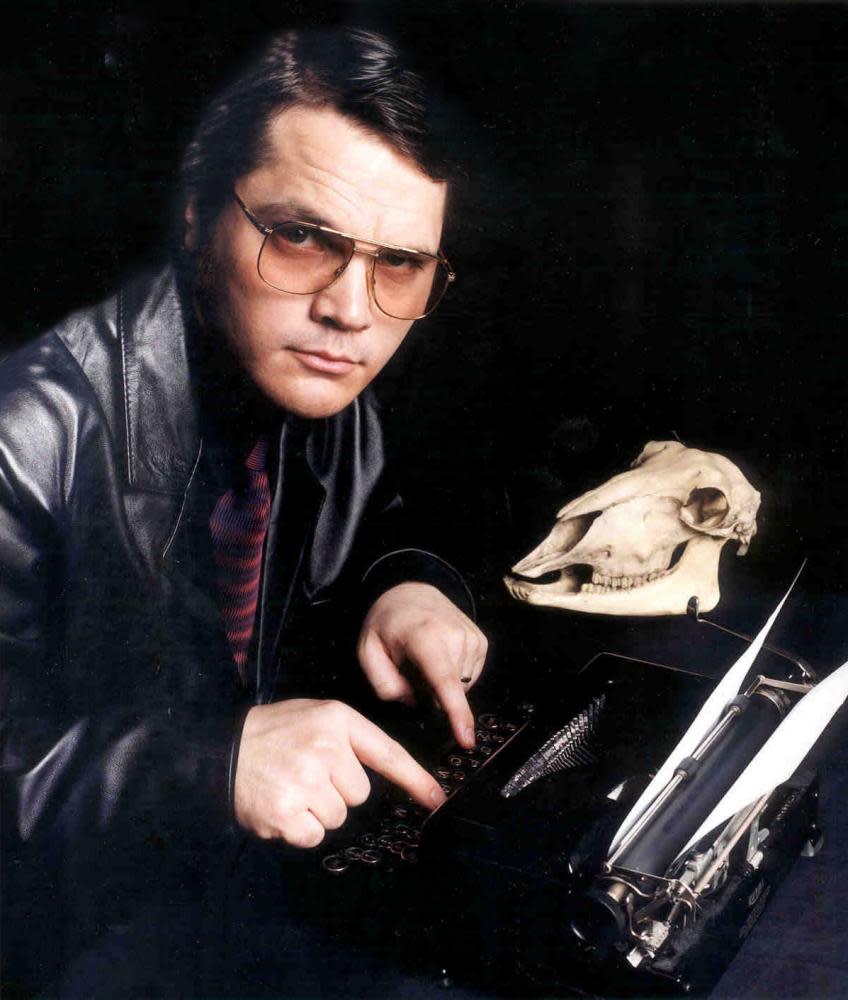Garth Marenghi: how the Edinburgh award winner found his Darkplace
Garth Marenghi, serious horror writer and self-described “master of the macabre”, was born in 1950 in east London. Yet it wasn’t until the mid-90s that he first appeared in public, reciting a passage from one of his many horror novels (he’s “one of the few people … who’ve written more books than they’ve read”) at a Cambridge University cabaret night.
Long before Garth Marenghi’s Darkplace – the Channel 4 series broadcast in 2004 – the prolific author was a star of the stage. Matthew Holness, the writer, actor and director behind the fictional horror writer, toured his Garth monologue with the Footlights. After university and temping by day, he then featured in the BBC sketch show Bruiser but felt “slightly disillusioned” with sketches. Holness began writing with Richard Ayoade, trying something character-led and horror-based. It was time for Marenghi to rise again.

Garth Marenghi’s Darkplace is a show within a show – characters give talking-heads commentary on the 1980s hospital-based horror series in which they starred. That conceit started on stage, where Ayoade’s character, publisher Dean Learner, would introduce Marenghi and his latest theatrical horror production. (Later, they would even stay in character during press interviews.)
“This writer was doing a very serious horror show and couldn’t understand why audiences were laughing – he was convinced it was a nervous reaction to sheer terror,” Holness says.
In 2000, they began experimenting at north London’s Hen and Chickens theatre pub, where The Mighty Boosh ran an alternative comedy night. They met Matt Berry who later joined the TV show. “Matt was doing strange Victorian characters, the Boosh were doing frightening comedy. They were little horror events,” says Holness.
The actor, writer and director Alice Lowe starred in the stage and TV versions of Garth Marenghi. When Holness and Ayoade decided to develop an hour-long Marenghi play for the Edinburgh fringe, they recruited Paul King (now a Bafta-nominated director) as director and Lowe as performer. Lowe hadn’t done comedy before and remembers being baffled watching them “running around in masks” at the Hen and Chickens.
Lowe and King had devised theatre shows together at university and brought this approach to Garth Marenghi. When Lowe suggested playing an animal, her character became an animal expert, who would in turn play a seagull and “a sad camel that sings songs”.
They created Garth Marenghi’s Fright Knight, starring Marenghi as writer Neil Hack, whose muse is kidnapped by a monster. Lowe says: “It was about bad theatre, but every moment was considered.”
By August 2000, they were in Edinburgh, performing to a near-empty room. While eating at a restaurant, they persuaded the waiting staff to come and watch. “They enjoyed it, but they were the only people there!” Lowe remembers. “That was my favourite gig,” Holness says. “I always found the bad gigs more enjoyable because they fit with the idea that Garth’s show was failing.” These became rare. Word spread, shows sold out and Fright Knight was nominated for the Edinburgh Comedy award.
They decided to take another show to Edinburgh in 2001. In Garth Marenghi’s Netherhead, Marenghi played Ken Dagless, descending into an Egyptian underworld to save his dead son. It featured deliberately bad props, including The Mind (“a papier maché brain on a broomstick with a cape around it”) and a giraffe headdress that caused Lowe to corpse when it collapsed spectacularly.
Holness admits Netherhead was less fun – pressure was high following Fright Knight’s success – but it too was nominated for the comedy award, and won. “That was amazing,” says Lowe. “There was disbelief for me; there weren’t many women at Edinburgh at that time. I never had plans to go into comedy or thought I would earn money being an actor. It was life-changing.”
Moving to TV, the team retained creative control – they were allowed to shoot on film, edit, and Ayoade directed. Stage experiences of collaboration, rehearsing to perfection, and mastering doing stuff badly paid off. They discovered the right way to get it wrong on TV such as continuity errors and overlit faces. In one scene, Lowe suggested she be wheeled in on a platform with no explanation: “It was joyous to be able to do stuff like that.”
Darkplace aired in 2004, relegated to a late-night weekday slot, and ratings were low. When the DVD was released in 2006, its popularity ballooned. Sadly, the chance for a second series (a parallel-universe Darkplace Hospital and snowed-in Christmas special) had passed. “I’d gone through the disappointment of having to say goodbye to it,” says Holness. “But we always knew it would have a following.”
Things you find funny are potentially related to things you find frightening
Regardless, the Garth Marenghi stage stars forged fascinating careers. Ayoade won a Bafta for his role in The IT Crowd, wrote and directed films and music videos, presents The Crystal Maze, and is now writing his first children’s book. Lowe and Holness both continued creating work with hints of Marenghi-style weirdness and gloom. Lowe wrote, directed and starred in horror-comedy films Sightseers and Prevenge. Most recently, she was in the BBC Sounds series The Sink, a surreal escape into someone else’s dreams. Like Marenghi, it allowed for improvisation, with Lowe drawing on ASMR. “I could take it as strange as I liked. You dream of jobs like that,” she says. “In retrospect, the fact that they were open to me being odd as a female performer [in Garth Marenghi] set a course for my career.”
Lowe is set to shoot a reincarnation romcom, Timestalker, and Holness has a horror film in production. Likewise, he has weaved darkness and humour through his work, from starring in Scandi-noir parody Angstrom, to writing and directing Possum, a sinister exploration of childhood trauma. “Most of the stuff I’m writing now is serious horror,” he says. “But things you find funny are potentially related to things you find frightening.”


